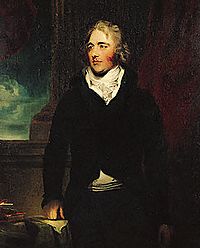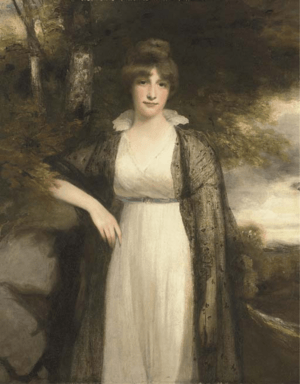Robert Hobart, 4th Earl of Buckinghamshire facts for kids
Quick facts for kids
The Earl of Buckinghamshire
|
|
|---|---|
 |
|
| Secretary of State for War and the Colonies | |
| In office 17 March 1801 – 12 May 1804 |
|
| Monarch | George III |
| Prime Minister | Henry Addington |
| Preceded by | New office |
| Succeeded by | The Earl Camden |
| Chancellor of the Duchy of Lancaster | |
| In office 23 June – 23 August 1812 |
|
| Monarch | George III |
| Prime Minister | The Earl of Liverpool |
| Preceded by | Spencer Perceval |
| Succeeded by | Charles Bathurst |
| Personal details | |
| Born | 6 May 1760 Hampden House, Great Hampden |
| Died | February 4, 1816 (aged 55) Hamilton Place, London |
| Nationality | British |
| Political party | Tory |
| Spouses | (1) Margaretta Bourke (died 1796) (2) Hon. Eleanor Eden (1777-1851) |
| Alma mater | None |
Robert Hobart, 4th Earl of Buckinghamshire (born May 6, 1760 – died February 4, 1816) was an important British politician. He was known as Lord Hobart from 1793 until 1804. He was also a member of the Privy Council, a group of advisors to the British monarch.
Contents
Early Life and Education
Robert Hobart was born at Hampden House in England. His father was George Hobart, 3rd Earl of Buckinghamshire. Robert went to Westminster School in London, which is a famous school.
Military Service
After school, Robert Hobart joined the military. He served in the American Revolutionary War, which was a big conflict between Great Britain and its American colonies. Later, he worked as an aide-de-camp (a personal assistant) to the leaders of Ireland starting in 1784.
Robert Hobart's Political Career
Robert Hobart had a long and active career in politics. He was a member of Parliament (MP) in both Ireland and Great Britain.
Serving in Parliament
He was an MP in the Irish House of Commons for different areas from 1784 to 1797. He also served in the British House of Commons. He represented areas like Bramber and Lincoln between 1788 and 1796.
Important Government Roles
In 1793, Robert Hobart became a member of the Privy Council. This meant he was a trusted advisor to the King. He was also appointed Governor of Madras in India.
Later, he held several high-ranking government jobs:
- Secretary of State for War and the Colonies (1801-1804): This role meant he was in charge of military matters and managing British colonies around the world. People said he understood the colonies very well.
- Chancellor of the Duchy of Lancaster (1805 and 1812): This was a government position that managed land and income for the British monarch.
- United Kingdom Postmaster General (1806-1807): He was in charge of the postal service.
- President of the Board of Control (1812-1816): This role involved overseeing British affairs in India.
The city of Hobart, which is the capital of Tasmania in Australia, was named after Lord Buckinghamshire.
Family Life
Lord Buckinghamshire married twice. His first wife was Margaretta Bourke, whom he married in 1792. They had one son who sadly died as a baby, and a daughter named Lady Sarah. Lady Sarah later married Lord Goderich, who became a Prime Minister.
After Margaretta passed away in 1796, he married Eleanor Agnes Eden in 1799. They did not have any children together.
Lord Buckinghamshire died in February 1816 when he was 55 years old. He passed away after falling from his horse. His nephew, George, became the next Earl of Buckinghamshire. Lady Buckinghamshire lived until October 1851.
| Parliament of Ireland | ||
|---|---|---|
| Preceded by John Scott Thomas Kelly |
Member of Parliament for Portarlington 1784 – 1790 With: Sir Boyle Roche, 1st Bt |
Succeeded by Richard Cavendish William Browne |
| Preceded by George Rawson Henry Duquery |
Member of Parliament for Armagh Borough 1790 – 1797 With: George Rawson 1790–1796 Sackville Hamilton 1796–1797 |
Succeeded by Sackville Hamilton Hon. Thomas Pelham |
| Parliament of Great Britain (1707–1800) | ||
| Preceded by Sir Henry Gough-Calthorpe, Bt Daniel Pulteney |
Member of Parliament for Bramber 1788 – 1790 With: Sir Henry Gough-Calthorpe, Bt |
Succeeded by Sir Henry Gough-Calthorpe, Bt Thomas Coxhead |
| Preceded by John Fenton-Cawthorne Richard Lumley-Saunderson |
Member of Parliament for Lincoln 1790 – 1796 With: John Fenton-Cawthorne 1790–1796 George Rawdon 1796 |
Succeeded by George Rawdon Richard Ellison |
| Political offices | ||
| Preceded by Alleyne FitzHerbert |
Chief Secretary for Ireland 1789–1793 |
Succeeded by Sylvester Douglas |
| Preceded by The Lord Grenville |
Leader of the House of Lords February–October 1801 |
Succeeded by The Lord Pelham |
| Preceded by Henry Dundas as Secretary of State for War |
Secretary of State for War and the Colonies 1801–1804 |
Succeeded by The Earl Camden |
| Preceded by The Lord Mulgrave |
Chancellor of the Duchy of Lancaster 1805 |
Succeeded by The Lord Harrowby |
| Preceded by Spencer Perceval |
Chancellor of the Duchy of Lancaster 1812 |
Succeeded by Charles Bathurst |
| Preceded by The Viscount Melville |
President of the Board of Control 1812–1816 |
Succeeded by George Canning |
| Peerage of Great Britain | ||
| Preceded by George Hobart |
Earl of Buckinghamshire 1804–1816 |
Succeeded by George Hobart-Hampden |
| Baron Hobart (writ of acceleration) 1798–1816 |
||


